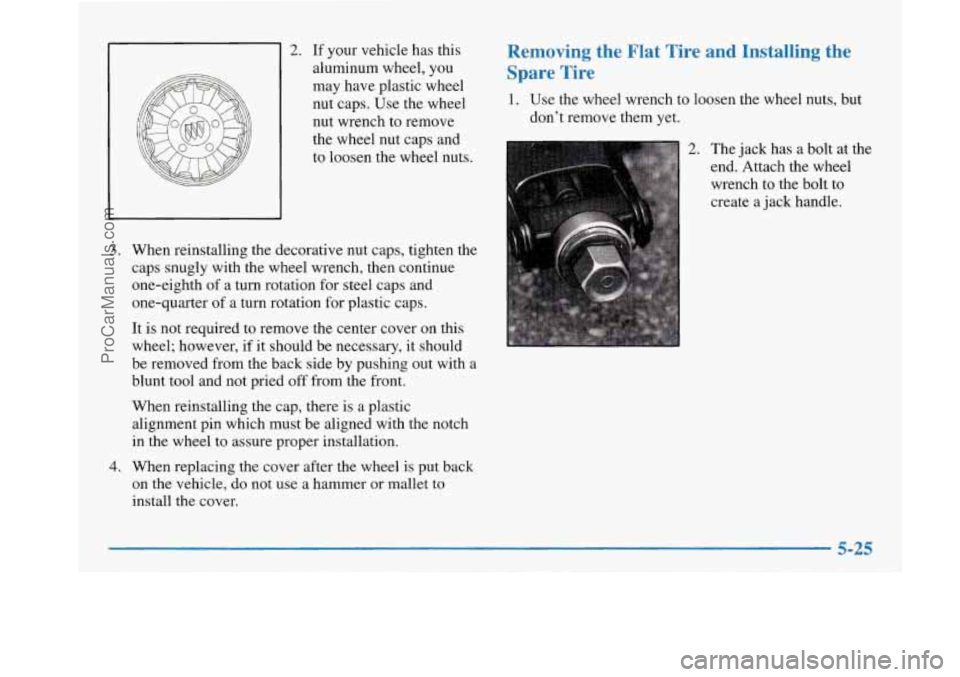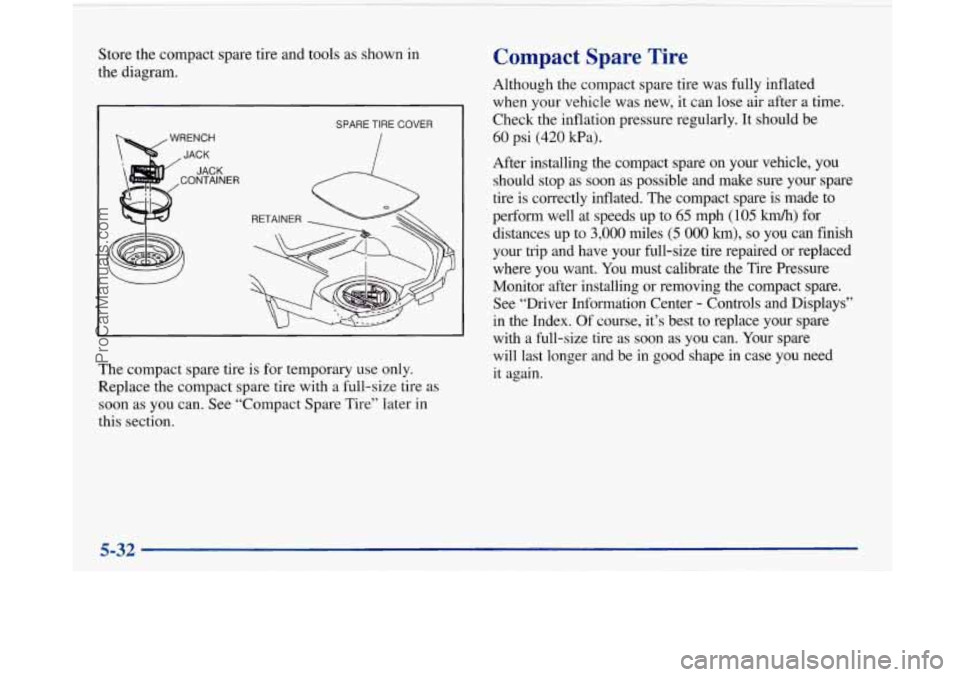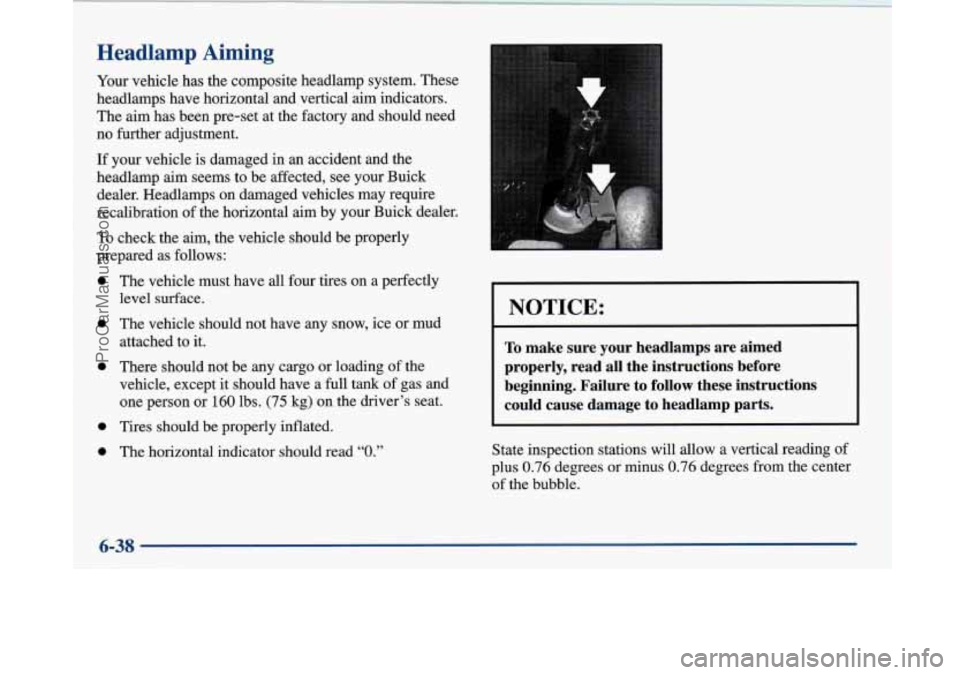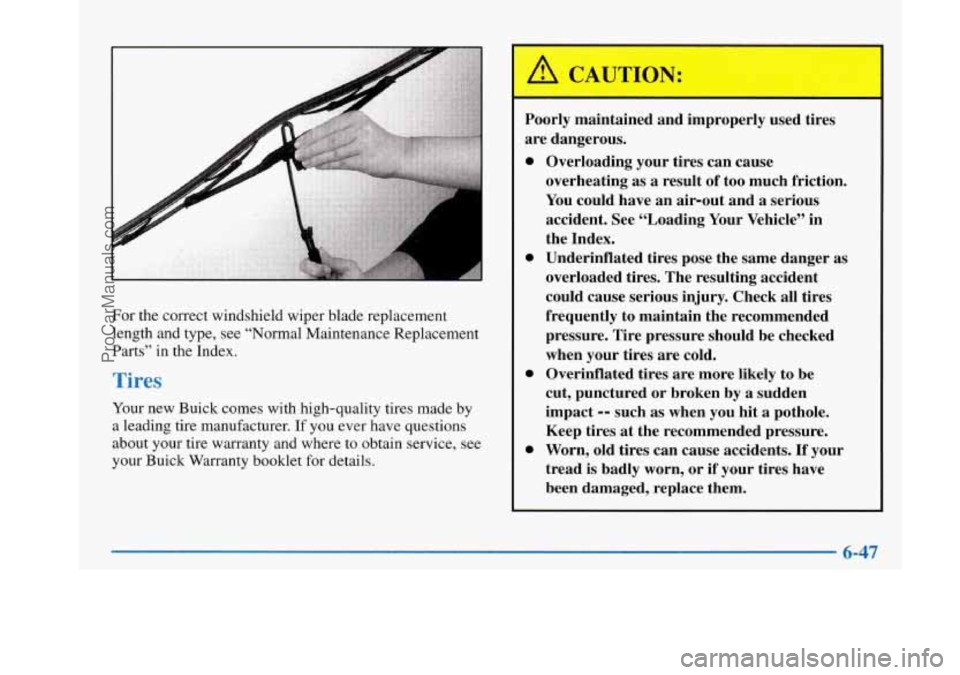Page 252 of 420
I
A
Remove the spare tire from the trunk. See “Compact
Spare Tire” later in this section for more information
about the compact spare.
The tools you’ll be using include the jack
(A) and the
wheel wrench
(B).
Wheel Covers
The following steps are necessary if you have the alloy
(aluminum) wheel with a center cover that conceals the
wheel nuts.
1. Insert the flat end of the wheel wrench in the notch and
pry
off the center cover. Do not drop the cover or lay it
face down, as it could be scratched or damaged.
5-24
ProCarManuals.com
Page 253 of 420

2. If your vehicle has this
aluminum wheel, you
may have plastic wheel
nut caps. Use the wheel
nut wrench to remove
the wheel nut caps and
to loosen the wheel nuts.
3. When reinstalling the decorative nut caps, tighten the
caps snugly with the wheel wrench, then continue
one-eighth
of a turn rotation for steel caps and
one-quarter of a turn rotation for plastic caps.
It
is not required to remove the center cover on this
wheel; however, if it should be necessary, it should
be removed from the back side by pushing out with a
blunt tool and not pried
off from the front.
When reinstalling the cap, there
is a plastic
alignment pin which must be aligned with the notch
in the wheel to assure proper installation.
4. When replacing the cover after the wheel is put back
on the vehicle, do not use
a hammer or mallet to
install the cover.
Removing the Flat Tire and Installing the
Spare Tire
1. Use the wheel wrench to loosen the wheel nuts, but
don’t remove them yet.
2. The jack has a bolt at the
end. Attach the wheel
wrench to the bolt to
create a jack handle.
5-25
ProCarManuals.com
Page 255 of 420
Getting under a vehicle when it is jacked up is
dangerous.
If the vehicle slips off the jack, you
could be badly injured
or killed. Never get under
a vehicle when it is supported only by a jack.
Raising
your vehicle with the jack improperly
positioned can damage the vehicle and even make
the vehicle fall.
To help avoid personal injury
and vehicle damage, be sure to
fit the jack lift
head into the proper location before raising
the vehicle.
5. Raise the vehicle by rotating the wheel wrench
clockwise in the jack. Raise the vehicle
far enough
off the ground
so there is enough room for the spare
tire to fit.
6. Remove all the wheel nuts and take off the flat tire.
5-27
ProCarManuals.com
Page 258 of 420
NOTICE:
Improperly tightened wheel nuts can lead to
brake pulsation and rotor damage.
To avoid
expensive brake repairs, evenly tighten the wheel
nuts in the proper sequence and to the proper
torque specification.
Don’t try to put a wheel cover on your compact spare
tire. It won’t fit. Store the wheel cover
in the trunk
until you have the flat tire repaired or replaced.
NOTICE:
Wheel covers won’t fit on your compact spare. If
you try to put a wheel cover on your compact
spare, you could damage the cover or the spare.
Storing the Flat Tire and Tools
L!b, CAUTION: I
Storing a jack, a tire or other equipment in the
passenger compartment
of the vehicle could
cause injury. In
a sudden stop or collision, loose
equipment could strike someone. Store all these
in the proper place.
After you’ve put the compact spare tire on your vehicle,
you’ll need
to store the flat tire in your trunk. Use the
following procedure to secure the flat tire in the trunk.
5-30
~
ProCarManuals.com
Page 259 of 420
Store the flat tire as far forward in the trunk as possible.
Store the jack and wheel wrench in their compartment in
the trunk. Storing the Spare Tire and Tools
A CAUTION:
Storing a jack, a tire or other equipment in the
passenger compartment
of the vehicle could
cause injury. In a sudden stop or collision,
loose
equipment could strike someone. Store all these
in the proper place.
ProCarManuals.com
Page 260 of 420

Store the compact spare tire and tools as shown in
the diagram.
A
SPARE TIRE COVER
The compact spare tire is for temporary use only.
Replace the compact spare tire with a full-size tire as
soon as you can. See “Compact Spare Tire” later in
this section.
Compact Spare Tire
Although the compact spare tire was fully inflated
when your vehicle was new,
it can lose air after a time.
Check the inflation pressure regularly. It should be
60 psi (420 Wa).
After installing the compact spare on your vehicle, you
should stop as soon as possible and make sure your spare
tire
is correctly inflated. The compact spare is made to
perform well at speeds up to
65 mph (105 km/h) for
distances up to
3,000 miles (5 000 km), so you can finish
your trip and have your full-size tire repaired or replaced
where you want. You must calibrate the Tire Pressure
Monitor after installing or removing the compact spare.
See “Driver Information Center
- Controls and Displays”
in the Index. Of course, it’s best to replace your spare
with a full-size tire as soon as you can. Your spare
will last longer and be in good shape
in case you need
it again.
5-32
ProCarManuals.com
Page 302 of 420

Headlamp Aiming
Your vehicle has the composite headlamp system. These
headlamps have horizontal and vertical aim indicators.
The
aim has been pre-set at the factory and should need
no further adjustment.
If your vehicle is damaged in an accident and the
headlamp
aim seems to be affected, see your Buick
dealer. Headlamps on damaged vehicles may require
~ recalibration of the horizontal aim by your Buick dealer.
To check the aim, the vehicle should be properly
prepared as follows:
0 The vehicle must have all four tires on a perfectly
level surface.
0 The vehicle should not have any snow, ice or mud
attached to it.
0 There should not be any cargo or loading of the
vehicle, except it should have a
full tank of gas and
one person or 160 lbs. (75 kg) on the driver’s seat.
0 Tires should be properly inflated.
0 The horizontal indicator should read “0.”
NOTICE:
I
~~
To make sure your headlamps are aimed
properly, read
all the instructions before
beginning. Failure to follow these instructions
could cause damage to headlamp parts.
State inspection stations will allow a vertical reading of
plus 0.76 degrees or minus 0.76 degrees from the center
of the bubble.
6-38
I
ProCarManuals.com
Page 311 of 420

For the correct windshield wiper blade replacement
length and type, see “Normal Maintenance Replacement
Parts” in the Index.
Your new Buick comes with high-quality tires made by
a leading tire manufacturer. If you ever have questions
about your tire warranty and where to obtain service, see
your Buick Warranty booklet for details.
Poorly maintained and improperly used tires
are dangerous.
0
0
0
0
Overloading your tires can cause
overheating
as a result of too much friction.
You could have an air-out and
a serious
accident. See “Loading Your Vehicle” in
the Index.
Underinflated tires pose the same danger
as
overloaded tires. The resulting accident
could cause serious injury. Check all tires
frequently to maintain the recommended
pressure. Tire pressure should be checked
when your tires are cold.
Overinflated tires are more likely
to be
cut, punctured or broken by a sudden
impact
-- such as when you hit a pothole.
Keep tires
at the recommended pressure.
Worn, old tires can cause accidents.
If your
tread
is badly worn, or if your tires have
been damaged, replace them.
6-47
ProCarManuals.com